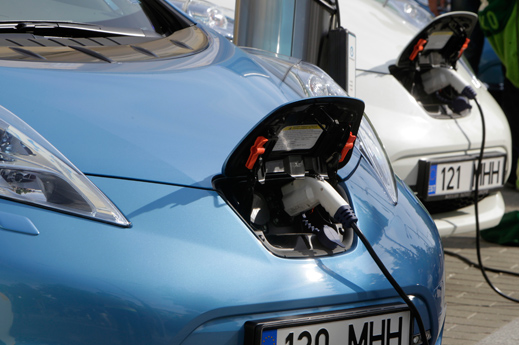How Improved Batteries Will Make Electric Vehicles Competitive
There are plenty of reasons why electric cars aren’t catching on, but one problem is certain: the batteries cost far too much.

For electric vehicles and plug-in hybrids to compete with gas-powered cars, battery prices need to drop by between 50 and 80 percent, according to recent estimates by the U.S. Department of Energy. Getting there might require inventing entirely new kinds of batteries, but there’s also a strong case that improvements to the lithium-ion batteries that power the current generation of electric vehicles may be enough.
The United States could have the capacity by 2015 to produce enough battery packs for 500,000 cars. But this year, due to high prices, plug-in vehicle sales won’t even reach a tenth of that in the United States. As a result, advanced battery makers in the United States have struggled. A123 Systems went bankrupt. Dow said its battery joint venture Dow Kokam had dropped markedly. And an LG Chem factory meant to supply batteries for the Chevrolet Volt has been built, but the factory is sitting idle, waiting for demand to pick up.
Electric vehicles cost less to operate than gas-powered ones, but that economic advantage largely disappears in the face of expensive batteries. The battery pack for the Chevrolet Volt costs about $8,000. The larger battery in the Nissan Leaf costs about $12,000.
The cost for the Leaf battery could drop to under $4,000 by 2025, according to a recent study by McKinsey, just by increasing the scale of battery production, forcing down component costs through competition, and approximately doubling the energy density of batteries, which reduces materials costs.
One startup, Envia Systems, has already built prototype lithium-ion battery cells that store about twice that of the best conventional lithium-ion batteries and can be recharged hundreds of times (see “A Big Jump in Battery Capacity” and “Should the Government Support Applied Research?”). And crucially, it’s similar enough to conventional lithium-ion batteries that it can be made on existing manufacturing equipment. The technology still needs work, and could take several years to start appearing in cars, the company says.
Jeff Dahn, a lithium-ion battery researcher at Dalhousie University, says cars like the Leaf and Volt use a special type of flat lithium-ion cell that is made with recently developed equipment that is still relatively slow. More conventional cylindrical lithium-ion cells cost roughly half as much to make because they use much faster equipment and are made at a larger scale. Dahn also notes that many of the components, such as a plastic film that separates electrodes in a battery, are overpriced. “You can’t tell me separator cost can’t come down.”
Not everyone agrees that lithium-ion batteries can reach the low costs needed for electric vehicles to compete with gas-powered ones (see “A123’s Technology Just Wasn’t Good Enough”). Toyota, for one, is investigating more dramatic changes in battery design. One type it’s developing replaces the liquid electrolyte in a conventional lithium-ion battery with a solid material, something that allows for a number of changes in the battery design that could shrink the system and lower the cost. These solid-state batteries and other technologies could cut the size of a battery pack by 80 percent, according to Toyota. Sakti3, a startup with close ties to GM, is also developing solid-state batteries, and recently started shipping prototype batteries to potential customers for testing, says CEO Ann Marie Sastry (see “Solid-State Batteries”).
24M, an early-stage startup based in Cambridge, Massachusetts, is taking a different approach—rather than an all-solid battery, the company is developing a cross between a battery and a fuel cell in which the battery electrodes are a sludgy liquid that can be pumped around. The energy storage material could be stored in inexpensive tanks, and then pumped into a small device to generate power (see “A Car Battery at Half the Price”).
Despite the novel designs, solid-state batteries and 24M’s technology still operate with a familiar lithium-ion chemistry, which could make them less risky to commercialize than more radical approaches that move beyond the lithium-ion chemistry. But alternatives to lithium ion batteries could be worth their added risk, since they have theoretical energy densities several times that of today’s electric car batteries.
The list is long, including lithium-sulfur, lithium-air, zinc-air, and magnesium-ion. But each seems to have its own unique problems. For example, lithium-air batteries, which could store 10 times more energy than conventional lithium-ion batteries (approaching the energy density of gasoline), use lithium metal, which can be very dangerous, and they can’t be recharged very many times.
Even if the issues for the new technologies can be solved in the lab, it could take decades to develop the manufacturing needed to reliably make the batteries in the large numbers needed to power cars. The process of solving these challenges will give conventional lithium-ion battery technologies a long time to improve.
Keep Reading
Most Popular
Large language models can do jaw-dropping things. But nobody knows exactly why.
And that's a problem. Figuring it out is one of the biggest scientific puzzles of our time and a crucial step towards controlling more powerful future models.
The problem with plug-in hybrids? Their drivers.
Plug-in hybrids are often sold as a transition to EVs, but new data from Europe shows we’re still underestimating the emissions they produce.
Google DeepMind’s new generative model makes Super Mario–like games from scratch
Genie learns how to control games by watching hours and hours of video. It could help train next-gen robots too.
How scientists traced a mysterious covid case back to six toilets
When wastewater surveillance turns into a hunt for a single infected individual, the ethics get tricky.
Stay connected
Get the latest updates from
MIT Technology Review
Discover special offers, top stories, upcoming events, and more.